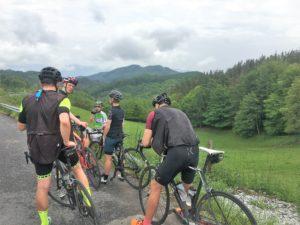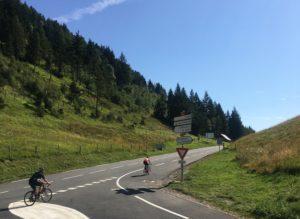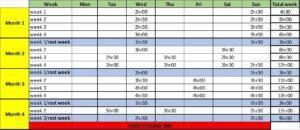How to Prepare for a Cycling Tour in 4 months ?
So you’ve decided to sign up for a French or European cycling tour ? Whether you’re riding through the Basque Country, the Raid Pyrenees, the Raid Alps or any other amazing adventure on two wheels, the best thing you can do to enjoy your time in the saddle is to make the proper preparations before you even take the first pedal stroke. In the last blog, we offered some tips on bike fit. This time, we’d like to talk about some basic but important training tips to prepare your legs and lungs for the kind of riding you’ll encounter each day on tour.

We know that most people can’t train a minimum of 20 hours each week like a professional, so we’ll explain a simple and realistic approach to getting in shape for a cycling tour in the mountains. First, we should recognize the two approaches to training: those who use a computer and/or power meter to help them train and those who ride and train by “feel” (we’ll provide you a basic chart at the end of the blog on how to improve fitness both ways, with or without technology). Second, there’s two basic but very important factors to training: time and intensity. This means how long you ride and how hard you push. Finally, we’ll discuss rest days and taper weeks…as time off the bike is just as important as training to gaining proper cycling fitness. Remember, the following may not be the perfect advice for every rider. As always, ride safely, happily and within your physical limits.
Most Bike Basque guests are not elite bike racers or professional cyclists. Well, neither are we! Most of you probably have a lifestyle full of work, family and non-cycling responsibilities that make training difficult. Don’t worry, you can still get fitter and faster with just two rides a week. Give yourself about four solid months before tour time to prepare. As you get closer to your tour date, try to squeeze in as much saddle time as possible, with three “training rides” a week being ideal. The other rides can be “easy”, like low-impact spins, commuting or a slow coffee ride.

Train gradually: Start slowly with shorter distances and easier efforts. If you start hammering your unfit legs or lungs, you could risk strains and injuries that can plague you for months. There is no shortcut to proper training. Don’t procrastinate! Start with short rides at a slow pace and work your way up. Begin with two rides a week, with those two rides totaling 5 hours if possible. Every two weeks, increase your saddle time by 30 minutes or more. Each ride, try to push yourself out of your “comfort zone” a bit more. It’s ok to feel a burn in your legs and lungs once in a while! Things like occasional, short sprints on the flats and up small hills (with recovery time in-between) can really help your legs build muscle and your lungs recover more quickly. If you feel fresh at the end of the week, you can begin the next week with two longer rides and so on. By the end of your 4-month training program, you should be able to comfortably pedal for up to 5 hours (with rest stops). Believe it or not, this is the equivalent of what you can expect to ride PER DAY for your next cycling tour.
Resting is key: it is very important to get plenty of rest and good nights’ sleep between each training ride. You should feel “fresh” every time you get on the bike. If you feel tired, feel free to skip a ride or go for a shorter/slower ride to just spin your legs. Sore or over-worked muscles need two days to recover, so plan your rides accordingly. The harder the effort, the more time you may need to recuperate. One very important rule to remember is that after 3 weeks of hard training per month, your 4th week should be a “rest week”. This is a great week for “soft pedal” rides. You should still ride for several hours each session, just don’t work on things like sprints or intervals or other taxing activities.
Since the Raid Pyrenees and Raid Alps are all about climbing epic mountains, try to climb as much as you can. We know our customers probably don’t live near the Pyrenees (lucky us!) but almost everyone has access to a local “hill” on which to train. There’s no need to turn yourself inside out trying to get to the top faster than everyone else… just climb at your own pace. Practice climbing at a comfortable, sustainable pace and in a fairly “easy” gear. This is around 80 revolutions per minute for those with a computer. If you don’t have a computer, search for a gear that feels easy enough for you to pedal consistently for at least 1 hour uphill. Remember, most of the big climbs in France can mean a 1 or 2 hour climb. Start climbs slowly and consistently, so you can enjoy the beauty of the summit.
Drink, drink, drink: it is another crucial piece of training advice ! Be sure to hydrate before, during and after your ride. Plain water works well for most people, but you can always add electrolytes to a bottle, especially during hot weather. If you add any supplements to one bottle, leave the other bottle full of plain water. The hotter is gets, the more you drink. The more you sweat, the more you drink. A good rule of thumb is to drink from your bidon every ten minutes of cycling.
Listen your body: perhaps the most important key to proper training. It will naturally improve after each training ride, especially if you allow time for recovery. Cyclists who “over-train” or wait until right before their tour, then cram difficult training sessions into the final weeks, are often fatigued and could end up having a frustrating time. Train hard enough and long enough so that you can come to the mountains and enjoy each day in the saddle. It will still be a challenge for sure and you should expect end each stage tired but happy, not tired and dreading the next day.
Finally, let’s talk briefly about intensity. This is how hard you should make each ride. A great, easy-to-follow intensity chart (and other training advice) can be found at the Apex Coaching website. What is important is knowing the different effort types or “zones” and how they relate to how hard you should ride during an effort. If you don’t know your FTP or RPE or ride, the intensity chart will help you to find them out, by the end of your four month training program, you should be training in the Z4a to Z4b zone.
Below, a very basic 4-month training plan:






